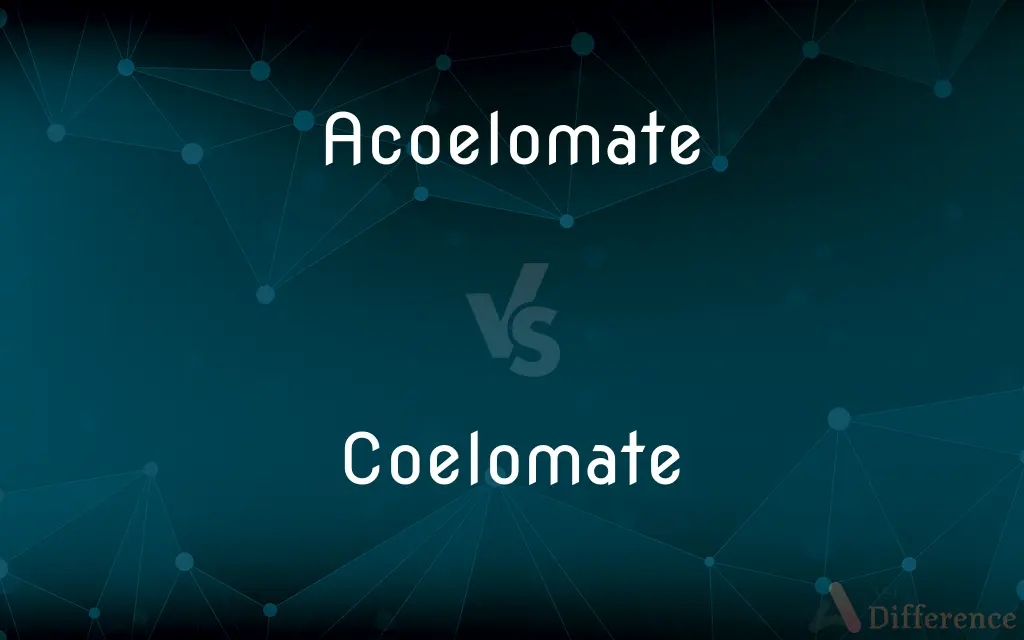Acoelomate vs. Coelomate — What's the Difference?
By Urooj Arif & Maham Liaqat — Updated on April 15, 2024
Acoelomates lack a body cavity between digestive tract and outer body wall; coelomates have a fully lined body cavity separating these structures.

Difference Between Acoelomate and Coelomate
Table of Contents
ADVERTISEMENT
Key Differences
Acoelomates are characterized by the absence of a coelom, which is a fluid-filled body cavity completely lined by tissue derived from mesoderm. On the other hand, coelomates possess a coelom, offering better organization of internal organs and more complex body structures.
In acoelomates, organs are embedded directly in the tissue called mesenchyme, limiting their mobility and flexibility. Whereas in coelomates, organs are suspended within the coelomic cavity, allowing for greater mobility and flexibility, which contributes to more efficient organ function.
Developmentally, acoelomates do not form a coelom during embryogenesis, leading to a simpler body plan. Coelomates, however, develop a coelom that is surrounded by a peritoneal lining, which aids in the development of more advanced systems like circulatory and excretory systems.
The simpler structure of acoelomates generally restricts them to smaller, less complex organisms such as flatworms. Coelomates, on the other hand, include a wide range of animals, from earthworms to humans, indicating a higher level of body organization and complexity.
Evolutionarily, the presence of a coelom in coelomates has allowed these organisms to develop more advanced and diverse forms of life, including higher metabolic rates and more complex behaviors, compared to the generally simpler acoelomates.
ADVERTISEMENT
Comparison Chart
Body Cavity
Absent
Present, fully lined with mesodermal tissue
Organ Mobility
Limited, organs embedded in mesenchyme
High, organs suspended in coelomic cavity
Complexity
Generally simpler organisms
More complex organisms
Evolutionary Development
No coelom, simpler embryonic development
Coelom forms during embryonic development
Example Organisms
Flatworms
Earthworms, humans
Compare with Definitions
Acoelomate
Features solid body tissue between gut and body wall.
In acoelomates, tissues are densely packed.
Coelomate
An organism with a coelom, a fluid-filled body cavity.
Humans are coelomates with complex internal structures.
Acoelomate
Typically found in simpler invertebrates.
Acoelomates include species like planarians.
Coelomate
Coelom lined with mesodermal tissue.
The coelom in coelomates supports organ development.
Acoelomate
Possesses a simpler body plan.
Acoelomates lack complex organ systems.
Coelomate
Allows high organ mobility and better structural complexity.
Coelomates' organs are well-protected yet movable.
Acoelomate
An organism without a coelom.
Most flatworms are acoelomates.
Coelomate
Includes most vertebrates and many invertebrates.
Coelomates range from earthworms to birds.
Acoelomate
An animal that lacks a coelom. Acoelomates, which include flatworms and tapeworms, exhibit bilateral symmetry and have no body cavity between the gut and the epidermis.
Coelomate
Capable of more advanced functions.
Coelomates show higher levels of locomotion and responsiveness.
Acoelomate
(zoology) Any animal without a coelom.
Coelomate
Possessing a coelom
A coelomate animal.
Acoelomate
(zoology) Having no coelom.
Coelomate
(zoology) Any animal possessing a fluid-filled cavity within which the digestive system is suspended.
Coelomate
(zoology) Having a coelom.
Common Curiosities
How does the absence of a coelom affect an organism?
The absence of a coelom generally limits organ mobility and flexibility, affecting the complexity and efficiency of organ systems.
What is a coelomate?
A coelomate is an organism with a coelom, a fluid-filled cavity that is completely lined by mesodermal tissue.
Can acoelomates be as large as coelomates?
Generally, acoelomates are smaller due to their simpler body structure and lack of internal body cavity.
What are the advantages of having a coelom?
The coelom allows for better organ protection, greater mobility, and the potential for more complex activities.
Which organisms are typically coelomates?
Coelomates include a wide range of animals, from earthworms to humans, featuring more complex body structures.
How does a coelom contribute to an organism's health?
The coelom allows for organ suspension and mobility, leading to more efficient functioning of systems like the circulatory and digestive systems.
What defines an acoelomate?
An acoelomate is an organism that lacks a coelom, which is a body cavity completely lined by tissue derived from mesoderm.
Are all invertebrates acoelomates?
No, not all invertebrates are acoelomates; some, like annelids and mollusks, are coelomates.
How do acoelomates and coelomates differ in their embryonic development?
Acoelomates do not form a coelom during embryogenesis, resulting in a simpler development process compared to coelomates.
Are acoelomates less evolved than coelomates?
While "less evolved" is not a precise scientific term, acoelomates typically exhibit simpler body structures and functionalities compared to coelomates.
What is the significance of mesoderm in coelomates?
Mesoderm is crucial for lining the coelom and forming the structures that support complex organ systems.
Do all animals have a coelom?
No, not all animals have a coelom. Only coelomates have a fully lined body cavity, while others may have no cavity or a partially lined cavity.
What evolutionary benefits does a coelom provide?
A coelom facilitates greater biological diversity and adaptation by enabling more complex body plans and functions.
Why are coelomates generally more complex than acoelomates?
The presence of a coelom allows for the development of complex organ systems and higher functional capabilities.
How do acoelomates manage organ functions without a coelom?
Acoelomates have organs embedded directly in solid mesenchymal tissue, which limits mobility but supports basic functions.
Share Your Discovery

Previous Comparison
Method vs. Technique
Next Comparison
Antiserum vs. VaccineAuthor Spotlight
Written by
Urooj ArifUrooj is a skilled content writer at Ask Difference, known for her exceptional ability to simplify complex topics into engaging and informative content. With a passion for research and a flair for clear, concise writing, she consistently delivers articles that resonate with our diverse audience.
Co-written by
Maham Liaqat














































